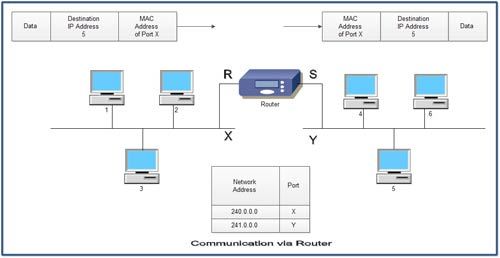Routers are used to connect both similar and dissimilar LANs. Router operates on the network layer of OSI model using the physical layer, data link layer and network layer to provide connectivity, addressing and switching. These are highly intelligent devices. In case of TCP/IP network, Internet Protocol (IP) is used as addresses for network; this is the router which interprets the IP address and delivers the packet reliably.
Now, we may say that router transmits the network layer data and therefore, provides transmission of data between LANs that use different data link protocols but using the same network layer protocol. Because of this, Etl1ernet can be connected with token ring network using routers. Additionally, routers provide connectivity La MAN (SMDS) and WAN (X.25, Frame Relay and ATM). Routers are protocol sensitive; typically supporting multiple protocols and large and varying packet sizes such as might be involved in supporting both Ethernet and Token Ring.
A network consisting of routers can have multiple paths unlike bridges. Normally, the shortest of all paths in the network is used to transfer packets.



Consider a case for data transmission from computer 1 to computer 5 on the network. When computer 1 starts sending the data, it compares its IP address with computer 5, i.e. destination computer addresses to know whether computer 5 lies on its own network or not. When computer 1 finds that it is not on its network, it transmits a data packet containing the MAC address R of router in this case. When router receives this packet, it sets the MAC address of computer 5 and sends packet to the port which has the same IP destination address as given in data packet. In this manner computer 5 receives the data packet.
We’ll be covering the following topics in this tutorial:
Characteristics of Routers
- Routers are multi-port devices with high – speed backbones
- Routers also support filtering and encapsulation like bridges
- Like bridges routers are also self-learning, as they can communicate their existence. to other devices and can learn of the existence of new routers, nodes and LAN segments
- As explained earlier, they route traffic by considering the network as a whole. It shows that they use a high level of intelligence to accomplish this task. This characteristic makes them superior than hubs and bridges because they simply view the network on a link-by-link basis
- The packet handled by router may include destination address, packet priority level, least-cost route, minimum route delay, minimum route distance, and route congestion level
- Routers constantly monitor the condition of the network, as a whole to dynamically adapt to changes in the condition of the network
- They typically provide some level of redundancy so that they are less susceptible to catastrophic failure.
Router Protocols
Router protocols consist of both bridging and routing protocols as listed below:
Inter-router Protocols
These are router-to-router protocols that can operate over dissimilar networks. This protocol routes information and stores data packets during periods of idleness.
Serial Line Protocols
This protocol is widely used over serial or dial-up links connecting unlike routers. Examples include HDLC, SLIP (Serial Line Interface Protocol), and PPP (Point-to-Point Protocol).
Protocol Stack Routing and Bridging Protocols
This advises the router as to which packets should be routed and which should be bridged.
 Dinesh Thakur holds an B.C.A, MCDBA, MCSD certifications. Dinesh authors the hugely popular
Dinesh Thakur holds an B.C.A, MCDBA, MCSD certifications. Dinesh authors the hugely popular